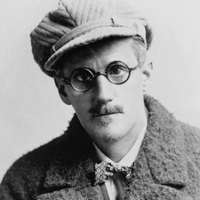James Joyce - Biography and Works
James Joyce (1882-1941) was born and educated in Dublin. Joyce found his early inspirations from the works of Henrik Ibsen, St. Thomas Aquinas and William Butler Yeats. He faces the implications of the loss of a world of public values in a very different way.

James Joyce
His belief of the alienation of the artist makes his attitude complicated. The artist had to be outside all conventions, all normal society because the artist must be outside society in order to be objective. And the artist must be objective if he is to adopt the peculiar microcosmic view that is the way of solving the modern problem for Joyce. Joyce sought a method of presenting a limited tract of time and space as microcosm, as a small-scale model of human life. The artist's function is not to render his own personal viewpoint, but to take all points of view and to construct in his fictional world on enormous interrelating, punning, and kaleidoscopic verbal universe.
In A Portrait of the Artist as a Young Man, he shows that art implies exile in such a way as to emphasize at every point the connection between the artist's objective, comprehensive, microcosmic vision and his inevitable alienation. The hero Stephen Dedalus firmly anchored in his family and in the institutions of his country at the beginning of the novel. They continue to put forth claims on him throughout the period of his growing up. But when he realizes at last that his destiny is to be free of all these claims, he had to learn to escape from them, to cultivate the terrible neutrality of the artist. Like the Greek Dedalus, Dedalus seeks to escape from the labyrinth of Dublin life and claims. Stephen was the first Christian martyr, Dedalus the first craftsman; in giving his hero the name of Stephen Dedalus, Joyce was emphasizing his view of the artist as outcast.
Ulysses is the work of the exiled artist re-creating at a distance, but with total knowledge of the life he has escaped from. Joyce expands the action of Ulysses into microcosm; he makes his account of the adventures of Leopard Bloom, the unsuccessful advertisement canvasser into a symbolic picture of all history and all experience. The seedy and unheroic Bloom is a true hero. Not only is he the humane, inquiring, but always inexpert, always the layman; he is also the Ulysses of Homer. Bloom, too, an Irish Jew, is both of Dublin and not of Dublin, both of a member of his community and an exile. He is the complete man, now hero and now fool. Ulysses is the comedy of multiple identities. Joyce seems to say that the significant is also the insignificant, the trivial is the heroic, the artist has all points of view because he has no point of view.
In conclusion, Joyce creates a hypertext with the presentation of multiple layers of point of view or consciousness. He is not concerned to show how to understand the object. His art is a sort of microcosm. For him, everything is not important and everything is important. He could not say that there is no hope in the society. He detaches himself from the society and presents different points of view. He has linguistic capability. Stream of consciousness technique is a basis for the plot construction. He made an attempt to identify abstract things regarding it as floating and transitory.
Features of Joyce's Writing
- Alienation resulting from public loss of standard.
- Mythical and historical experiences.
- Possibility of temptation and corruption.
- Multiple traces of meaning.
- Symbolic language.
- Linguistic intensity.
